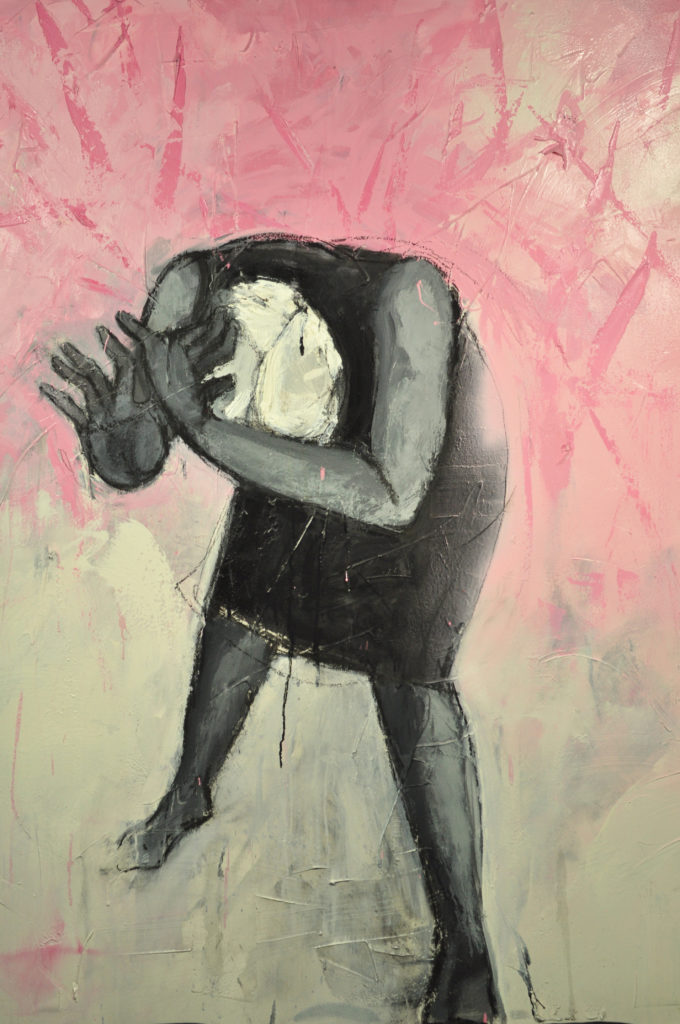
Fri 3/16-Fri 4/27
Just as important to the global awakening behind the #MeToo and Time’s Up movements is that of gender inequality.
Doing their part to address the latter topic are Cleveland artists Robert Banks and John W. Carlson with their creative new exhibit Don’t Be Still, which appears Fri 3/16-Fri 4/27 at the HEDGE Gallery located at 78th Street Studios.
Challenging the idea that the female is a non-equal counterpart to man, Banks has created a series of black & white films featuring images of oppression. The women subjects have their faces covered, and no words are spoken. For his part, Carlson’s distinctive oil paintings observe the human condition and address gender issues with images of women in black dresses and bags over their heads struggling with conflict.
CoolCleveland talked to both artists about the impetus and intended impact of Don’t Be Still.
CoolCleveland: First of all, how did you decide on this joint project?
Robert Banks: We both wanted to explore an idea and a topic that was relevant, but at the same time allowed us to merge traditional cinema and traditional painting.
John W. Carlson: Robert and I have been friends for about 10 years. We discovered through a friendship a mutual love of black and white photography, especially film noir, and implied narrative. We wanted to present these two disciplines as separate and as working as a total whole.
CC: How did you land on an exhibit examining gender inequality?
RB: Ironically, this wasn’t meant to be part of any neo-feminist movement. This was a sheer coincidence. We wanted to make an impact based on social-political strife with the new administration as a reminder that this is our way of asking the American male to “man up.”
JWC: We’re calling attention to gender inequality and to not just look at what these women have had to put up with — even though that’s a big part of it — but we’re also addressing the narrow male gender stereotypes that men have to live up to. If we can equal the playing field, we’re going to get along a heck of a lot better.
CC: Examining Don’t Be Still, do you feel the films and paintings provide an element of balance or juxtaposition?
JWC: Well, by their very nature, each one will take the viewer to another place. When you meet its presence with your presence, this amazing thing happens: It awakens things in the viewer.
CC: Robert, what was the driving creative force?
RB: We wanted an idea that was both psychologically claustrophobic, as well as defensive, in visual nature. Instead of shooting a standard digital video, we went for traditional, in-your-face, balls-to-the-wall, underground celluloid aesthetic. Very true to the traditional German Expressionist.
CC: John, was there something you wanted to avoid when creating pieces for Don’t Be Still?
JWC: Northing gratuitous or overt or cheap. We decided the gestures in the paintings and the film would be an implied violence or an implied struggle. We talked a lot about one of our favorite films Psycho and that famous shower scene. We know this woman is being knifed, but you never see the knife enter her flesh. So we wanted to kind of run things along that line. It’s required of the viewer to explore and create the narrative in their minds.
CC: Finally, what do you hope viewers take away from Don’t Be Still?
RB: More than anything, we want people to look in the mirror and ask themselves, “What is my motivation for my compassion for my better half? Does she need protection? Does she need support? Does she need empathy? And, throughout everything a woman has to deal with, is she prepared to embrace a man’s ideology in the 21st century?”
JWC: We want them to reboot and think about what all of this means and especially for men to look a little deeper at what being a man is. Maybe what we think would be advantageous is a man being brave enough to be sensitive to women’s issues and not be at war.